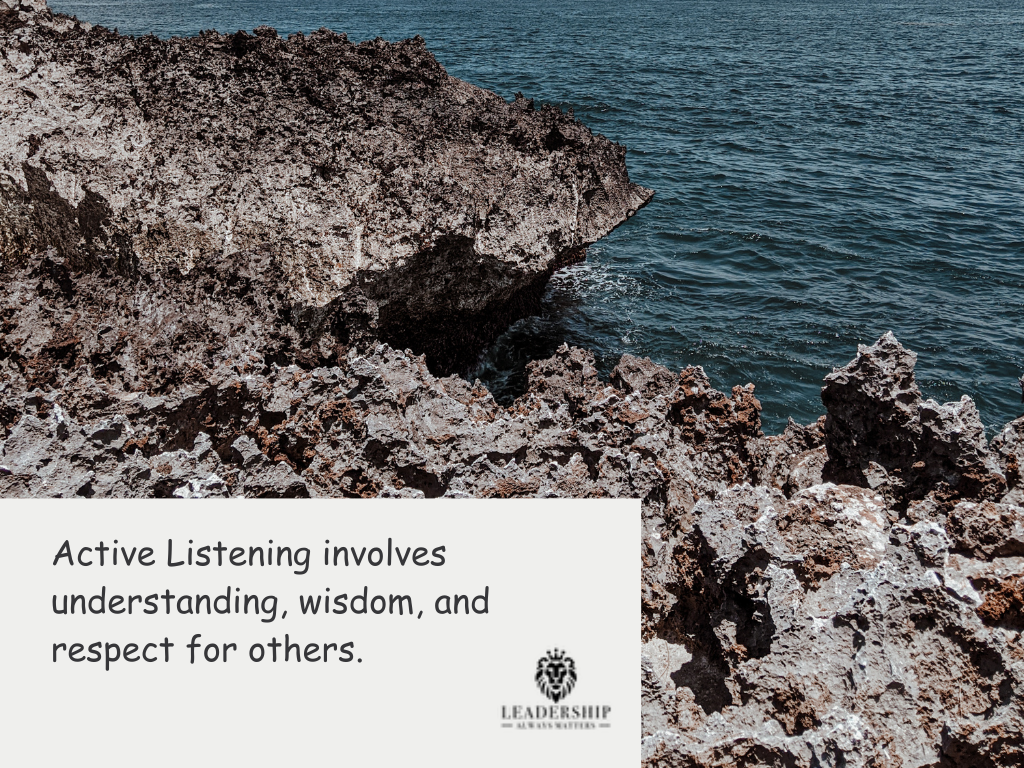8 Ways Leaders Transform Conversations
Before we begin
I promised you about The Leadership Trait Theory. The theory from the 1940’s came from the idea that leaders are born, not made. That they were born with specific qualities: intelligence, self-confidence, determination, integrity and sociability.
Of course there was much criticism about this. People argued that not everyone with those traits became successful leaders. Years later, research was conducted that included situations and other qualities. So, this is a list of common traits studied in leadership (there are more) throughout the years.
Note: Resilience was discussed, last week. If there’s a topic you would like to know more about, post it on the comments section and I will be happy to discuss it.
Let’s Talk Leadership!
It’s called Active Listening, a foundational leadership skill, essential for good communication, to build trust, and to effectively address challenges.
What is the difference between listening and active listening?
Listening is just the act of hearing and processing the words someone is saying. You are not fully engaged or may be distracted. When you respond, you do it automatically, without fully understanding the speaker’s message or emotions.
Active Listening: is listening with the intent to understand the speaker completely, even their emotions. When you actively listen, you pay full attention and show genuine interest. You are engaged and focused.
What are some techniques to improve listening?
Non-Verbal Cues: Maintain eye contact, nod, and use facial expressions to show that you’re paying attention.
Verbal Feedback: Use phrases like, “I see,”, “I understand,” or paraphrase what the speaker said to confirm understanding.
Seek Clarification: Ask questions to clarify points and ensure understanding.
Reflective Listening: Reflect on what the speaker said, by summarizing or restating their message.
Show Empathy: Understand and acknowledge the speaker’s feelings and emotions.
To summarize, listening is passive and superficial--- while active listening requires your full attention, and engagement. Active listening takes effort. You make an effort to understand and respond thoughtfully. It’s essential for communication, stronger relationships, and for effective problem-solving. Take a look at the following diagram and what it takes to improve your active listening skills.
Do you know…
The Bible has insights and teachings about the importance of active listening? It highlights that listening is not just about hearing words. It involves understanding, wisdom, and respect for others. That is active listening.
Here are some key verses and principles for further reading.
Listening, according to the Bible, is fundamental to living a life of faith, wisdom, and compassion. It involves actively engaging with God’s word, being open to learning and correction, showing empathy, and understanding others.
In other words, active listening is a critical component of a righteous and wise life!
"One of the most sincere forms of respect is actually listening to what another has to say.”
— —-Bryant H. McGill
How does active listening impact effective leadership?
Active listening plays a vital role in building trust, getting collaboration, and having clear communication.
1. Building Trust and Relationships:
Active listening helps you build trust and rapport with your team members. When you genuinely listen, you send the message that you value and respect their opinions, this in turn, strengthens relationships.
2. Enhancing Communication:
Active listening ensures clear communication. If you listen well, you can understand and interpret messages accurately. You can minimize misunderstandings and improve overall communication.
3. Empathy and Understanding:
Active listening allows you to understand your team members’ concerns, and motivations. This empathy helps you respond appropriately to their needs and challenges, plus, you create a supportive and kind work environment.
4. Encouraging Participation:
With active listening you are able to encourage others to voice their ideas and opinions. This approach increases engagement, innovation, and a sense of ownership among your team members.
5. Conflict Resolution:
Active listening is essential for resolving conflicts effectively. You can understand the root causes of conflicts and come up with fair solutions for all.
6. Decision-Making:
With active listening you can make informed decisions, by gathering relevant information. It helps you consider different viewpoints before coming to a conclusion.
7. Learning and Growth:
With active listening you are more likely to receive constructive feedback and learn from experiences. This openness to feedback creates continuous learning and personal development.
8. Empowering Others:
With active listening, you empower your team members to take initiative and contribute. It creates an environment where people feel heard and valued. Most important, it leads to higher morale and productivity.
Active listening is a foundational leadership skill. You need it to deal with challenges, enhance communication, and build trust. Just as important, it can be used to create a positive and productive work environment.
Have a good weekend!
—-Dr. Aguilar





